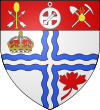| Part of a series on | ||||||||||||||||||||||||||||||||||||||||
| History of Ottawa | ||||||||||||||||||||||||||||||||||||||||
|---|---|---|---|---|---|---|---|---|---|---|---|---|---|---|---|---|---|---|---|---|---|---|---|---|---|---|---|---|---|---|---|---|---|---|---|---|---|---|---|---|
 | ||||||||||||||||||||||||||||||||||||||||
|
||||||||||||||||||||||||||||||||||||||||
| Timeline | ||||||||||||||||||||||||||||||||||||||||
|
||||||||||||||||||||||||||||||||||||||||
| Historical individuals | ||||||||||||||||||||||||||||||||||||||||
|
| ||||||||||||||||||||||||||||||||||||||||
The history of Ottawa, capital of Canada, [1] was shaped by events such as the construction of the Rideau Canal, the lumber industry, the choice of Ottawa as the location of Canada's capital, as well as American and European influences and interactions. By 1914, Ottawa's population had surpassed 100,000 and today it is the capital of a G7 country whose metropolitan population exceeds one million.
The origin of the name "Ottawa" is derived from the Algonquin word adawe, meaning "to trade". The word refers to the indigenous peoples who used the river to trade, hunt, fish, camp, harvest plants, ceremonies, and for other traditional uses. The first maps made of the area started to name the major river after these peoples.
For centuries, Algonquin people have portaged through the waterways of both the Ottawa River and the Rideau River while passing through the area. French explorer Étienne Brûlé was credited as the first European to see the Chaudière Falls in 1610, and he too had to portage past them to get further inland. No permanent settlement occurred in the area until 1800 when Philemon Wright founded his village near the falls, on the north shore of the Ottawa River.
The construction of the Rideau Canal, spurred by concerns for defense following the War of 1812 and plans made by Lieutenant Colonel John By and Governor General Dalhousie began shortly after September 26, 1826 when Ottawa's predecessor, Bytown was founded. Lt. Colonel John By was an officer of the Royal Engineers commissioned by the British Government in 1826 to superintend the construction of the Rideau Canal.[2]
The founding was marked by a sod turning, and a letter from Dalhousie which authorized Colonel By to divide up the town into lots.[3] The town developed into a site for the timber, and later sawed lumber trade, causing growth so that in 1854, Bytown was created a city and its present name, Ottawa was conferred.[2]
Shortly afterward, Queen Victoria chose Ottawa as the capital of Canada; and the parliament buildings on Parliament Hill were soon completed. Also at this time, increased export sales led it to connect by rail to facilitate shipment to markets especially in the United States. In the early 1900s the lumber industry waned as both supply and demand lessened.
Growth continued in the 20th century, and by the 1960s, the Greber Plan transformed the capital's appearance and removed much of the old industrial infrastructure. By the 1980s, Ottawa had become known as Silicon Valley North after large high tech companies formed, bringing economic prosperity and assisting in causing large increases in population in the last several decades of the century. In 2001, the city amalgamated all areas in the former region, and today plans continue in areas such as growth and transportation.
© MMXXIII Rich X Search. We shall prevail. All rights reserved. Rich X Search
